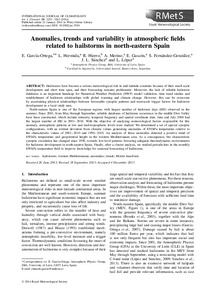Por favor, use este identificador para citar o enlazar este ítem:
http://hdl.handle.net/20.500.11765/10160
Anomalies, trends and variability in atmospheric fields related to hailstorms in north‐eastern Spain
| Título : | Anomalies, trends and variability in atmospheric fields related to hailstorms in north‐eastern Spain |
| Autor : | García Ortega, Eduardo; Hermida González, Lucía; Hierro, Rodrigo; Merino Suances, Andrés; Gascón, Estíbaliz; Fernández-González, Sergio



|
| Palabras clave : | Hailstorms; Western Mediterranean; Anomalies; Trends; Morlet transform |
| Fecha de publicación : | 2014 |
| Editor: | Royal Meteorological Society; Wiley |
| Citación : | International Journal of Climatology. 2014, 34(11), p. 3251-3263 |
| Versión del editor: | https://dx.doi.org/10.1002/joc.3910 |
| Resumen : | Hailstorms have become a serious meteorological risk in mid-latitude countries because of their small-scale development and short time span, and their forecasting remains problematic. Moreover, the lack of reliable hailstorm databases is an important handicap for Numerical Weather Prediction (NWP) model validation, time trend studies and establishment of hailstorm relationships with global warming and climate change. However, this can be overcome by ascertaining physical relationships between favourable synoptic patterns and mesoscale trigger factors for hailstorm development in a local study area. North-eastern Spain is one of the European regions with largest number of hailstorm days (HD) observed in the summer. Since 2001, from May through September, reliable databases of hailstorm occurrence in the middle Ebro Valley have been constructed, which include intensity, temporal frequency and spatial coordinate data. June and July 2006 had the largest number of HD in 2001–2010. With the objective of analysing meteorological factors responsible for this anomaly, atmospheric patterns at low and mid-tropospheric levels were studied. We determined a set of special synoptic configurations, with an evident deviation from climatic values generating anomalies of 850 hPa temperature relative to the characteristic values of 2001–2010 and 1950–2010. An analysis of these anomalies detected a positive trend of 850 hPa temperature and geopotential height in the western Mediterranean area. As a consequence, the characteristic synoptic circulation has changed since 1950, towards low-level patterns favouring adequate thermodynamic environments for hailstorm development in north-eastern Spain. Finally, after a cluster analysis, we studied periodicities in the monthly 850 hPa temperature field to improve knowledge for seasonal forecasting of hailstorms. |
| Patrocinador: | The study was supported by the Plan Nacional de I+D of Spain through grant CGL2010-15930 and the Junta de Castilla y León through grant LE176A11-2. |
| URI : | http://hdl.handle.net/20.500.11765/10160 |
| ISSN : | 0899-8418 1097-0088 |
| Colecciones: | Artículos científicos 2010-2014 |
Ficheros en este ítem:
| Fichero | Descripción | Tamaño | Formato | ||
|---|---|---|---|---|---|
| Garcia-Ortega_2014_In... | 2,89 MB | Adobe PDF |  Visualizar/Abrir |
Los ítems de Arcimis están protegidos por una Licencia Creative Commons, salvo que se indique lo contrario.





